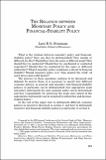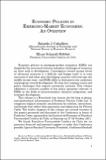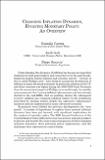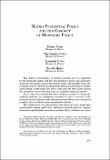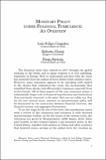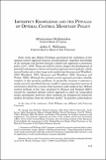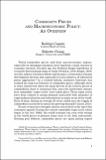Buscar
Mostrando ítems 1-10 de 511
The relation between monetary policy and financial-stability policy
What is the relation between monetary policy and financialstability policy? How can they be distinguished? How similar or different are they? Should they have the same or different goals? How should they be conducted? Should they be coordinated or conducted separately? Should they be conducted by the ...
Economic policies in emerging-market economies: an overview
Economic policies in emerging-market economies (EMEs) are shaped by the structural features and policy challenges of countries on their road to development. Convergence toward income levels of advanced countries is a difficult and bumpy road—it is even uncertain if and when most developing countries ...
The fiscal footprint of macroprudential policy
, and this creates seignorage revenues. Inflation unexpectedly rises and this lowers the real value of public debt. Rolling over this debt is cheaper as the price of newly issued debt rises. And finally, economic activity rises, so tax revenues increase and social...
Changing inflation dynamics, evolving monetary policy: an overview
Understanding the dynamics of inflation has become an important challenge for both policymakers and researchers over the past decade. Empirical models linking inflation and economic activity—versions of the so-called Phillips curve—have failed...
Risks to central-bank independence
their power or remit. These include everything from enhanced financial regulation to quasi-fiscal policy to mitigating economic inequality. Some recent populist proposals appear to be based on the presumption that central banks can issue large quantities...
Macro-prudential policy and the conduct of monetary policy
The 'Great Contraction' in global economic activity triggered by the financial crisis and the extraordinary fiscal and monetary measures that public authorities had to undertake in order to put the economy back on track by putting public finances under heavy strains and leading to extremely low ...
Monetary policy under financial turbulence: an overview
The financial crisis that started in 2007 brought the global economy to the brink and in many respects it is still unfolding especially in Europe. How to understand and deal with the crisis has naturally been the subject of fierce debates that continue today. However some consensus appears to be ...
Imperfect knowledge and the pitfalls of optimal control monetary policy
Sixty years ago, Milton Friedman questioned the usefulness of the optimal control approach because of policymakers’ imperfect knowledge of the economy and favored instead a simple rule approach to monetary policy (1947, 1948). These are still live issues, despite the development of powerful techniques ...
Commodity prices and macroeconomic policy: and overview
World commodity prices and their macroeconomic impact especially on emerging economies have long been a main concern in economic research. Decades ago the Prebisch-Singer hypothesis of secularly deteriorating terms of trade (Prebisch 1950 Singer 1950) was the subject of intense debate and became a ...
International risk spillovers: implications for emerging markets’ monetary policy frameworks with an application to Chile
Among the factors behind international spillovers, U.S. monetary policy developments retain a major influence. Such developments
drive the global financial cycle as strongly demonstrated by Rey (2013), Miranda-Agrippino and Rey (2020), Miranda-Agrippino and
Rey (2021). The dramatic U.S. monetary ...

